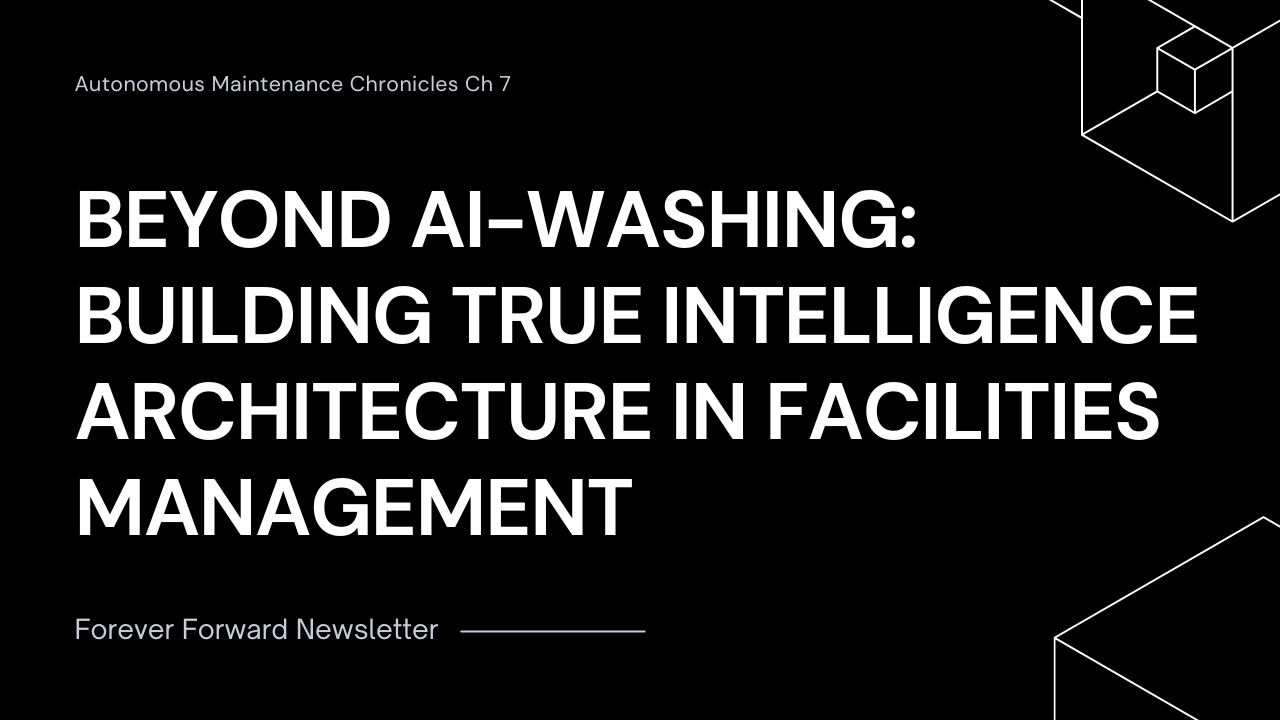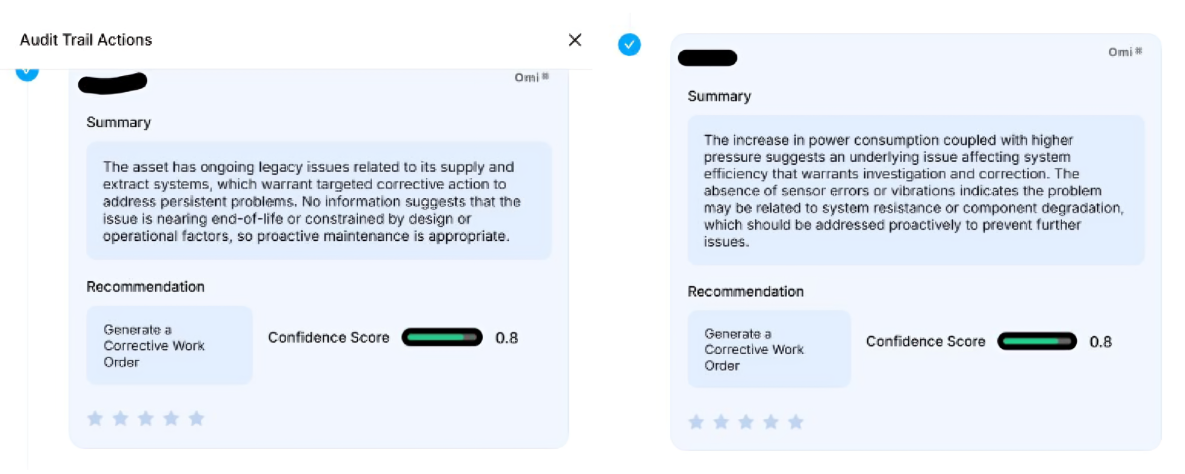
Published on :
In Chapter 6, we covered how AI can unlock both speed and precision in triaging to transform it from a bottleneck into a performance multiplier. This time, we're diving into the role of system autonomy and intelligence in decision-making. And that brings us to a harder, deeper challenge — one we see across the FM landscape today.
The facilities management industry is drowning in 'AI-powered' solutions that are anything but intelligent. From predictive maintenance platforms that are glorified trending algorithms to "smart" building systems that are just sophisticated alerting mechanisms, the market is saturated with AI washing — superficial machine learning applied to traditional problems without fundamental architectural innovation.
The true nature and potential of AI in facilities management requires something entirely different: deep intelligence architecture that mirrors how expert FM professionals think, reason, and make decisions. This isn't about adding ML models to existing workflows; it's about rebuilding the decision-making foundation of facilities management from the ground up.
This chapter is about that distinction — and why, if we want to build something truly successful, we need to go much deeper than most are willing to go.
True AI systems in facilities management are built on multiple cognitive layers, each adding contextual intelligence that shallow implementations cannot achieve. It needs depth — a multi-layered architecture that reflects how expert decision-makers operate in complex environments. Here’s what that looks like:
Beyond simple sensor integration, deep AI systems synthesize disparate data streams — environmental sensors, occupancy patterns, energy consumption, work order histories, vendor performance, weather forecasts, and business calendars — into coherent situational awareness. This isn't data aggregation; it's contextual understanding.
Rather than hard-coded rules, sophisticated AI embeds organizational knowledge, regulatory requirements, operational constraints, and business priorities into dynamic policy frameworks. The system doesn't just follow rules; it interprets policies in context, weighs competing priorities, and makes nuanced decisions that respect complex organizational realities.
Deep AI systems model the downstream effects of maintenance decisions across multiple dimensions: occupant impact, business continuity, cost implications, regulatory compliance, and asset lifecycle considerations. This predictive modelling enables the system to choose optimal intervention strategies rather than reactive fixes.
True AI doesn't just make decisions; it understands the quality of its own reasoning. Confidence scoring mechanisms enable the system to differentiate between high-certainty autonomous decisions and complex scenarios requiring human oversight. This meta-cognitive awareness is what separates intelligent systems from sophisticated 'automation'.
Organizations embracing deep intelligence architecture in facilities management are unlocking capabilities that go far beyond automation and operational upgrades — they represent a new way of thinking, deciding, and scaling expertise.
Institutional Knowledge Scaling: Expert FM decision-making patterns are encoded and replicated across entire facility portfolios. The system learns not just from data patterns but from how experienced professionals interpret and act on those patterns.
Contextual Decision Making: Rather than triggering on thresholds, the AI evaluates situations holistically. An HVAC anomaly might be ignored during low occupancy periods but escalated immediately before a critical business event. This contextual awareness cannot be achieved through rule-based systems.
Continuous Learning Architecture: Deep systems improve their decision-making quality through feedback loops, learning from outcomes, and refining policy interpretations. The AI becomes more intelligent over time, not just more accurate.
Multi-Stakeholder Optimization: Advanced systems balance competing objectives — cost minimization, occupant comfort, regulatory compliance, asset longevity, and so on. Deep AI systems can weigh these objectives simultaneously and propose decisions that satisfy not just the system, but the people it serves.
The gap between AI washing and deep intelligence architecture is becoming a fundamental competitive divide in facilities management:
Organizations that have invested in deep AI architecture report operational improvements that go far beyond efficiency gains. They describe fundamental transformations in how facilities are managed—from reactive problem-solving to predictive optimization, from resource-intensive operations to autonomous intelligence.
Building deep intelligence architecture in facilities management isn’t about layering AI on top of existing systems. It requires rethinking how systems are designed, trained, and evolved from the ground up.
Before you deploy features, define the foundation: How should the system think? What kinds of decisions should it be making? What knowledge, policies, and priorities should shape those decisions? This is cognitive architecture, not software architecture.
The real competitive advantage lies not in fancy algorithms, but in how well you encode institutional knowledge—decision frameworks, constraints, judgment logic. This requires deep collaboration between AI teams and the FM professionals who’ve lived the complexity.
True intelligence systems don’t just execute—they learn. You’ll need infrastructure for feedback loops, outcome tracking, and model refinement—so the system gets smarter with every decision it makes.
If the AI makes a recommendation, you need to know why. Trust is built through transparency — clear reasoning, auditable logic paths, and confidence scores. This shouldn’t be an add-on. It needs to be part of the architecture from day one.
Where most systems stop, Omi adds another layer of decision intelligence. Here’s how its decision-making process works:
Omi evaluates each potential work order against multiple policy dimensions:

This approach helps prevent unnecessary or misaligned interventions while ensuring that critical issues don’t slip through the cracks. It’s not just about diagnosing faults — it’s about making decisions that are technically sound, policy-aware, and contextually justified.
Facilities management is at an inflection point. In the short term, surface-level AI may appear “good enough.” It automates some tasks, reduces a bit of noise, and creates the illusion of progress. But in the long run, organizations that stop there will find themselves competing against fundamentally more intelligent operations — systems that think, reason, and improve with every cycle.
Deep AI architecture doesn’t just optimize operations — it compounds into a competitive moat. As these systems learn, adapt, and codify decision-making at scale, they become exponentially harder to replicate or catch up to.
The real choice facing leadership today isn’t whether to implement AI in FM. It’s whether to build genuine intelligence or settle for sophisticated automation.
One creates leverage. The other creates technical debt, disguised as innovation.
The time for AI washing is over. The era of intelligence architecture has begun.
_________
What's your experience with AI implementations in facilities management? Have you encountered the difference between surface-level automation and deep intelligence architecture?
*****
Loving it so far? Stay tuned for the next episode of Autonomous Maintenance Chronicles!
Lorem ipsum dolor sit amet, consectetur adipiscing elit, sed do eiusmod tempor incididunt ut labore et dolore magna aliqua. Ut enim ad minim veniam, quis nostrud exercitation ullamco laboris nisi ut aliquip ex ea commodo consequat. Duis aute irure dolor in reprehenderit in voluptate velit esse cillum dolore eu fugiat nulla pariatur.
Block quote
Ordered list
Unordered list
Bold text
Emphasis
Superscript
Subscript
© Xempla. All rights reserved.